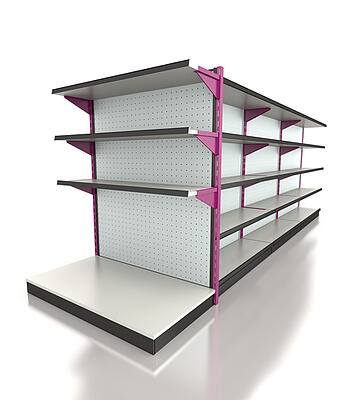 Shelving systems work together for a customized look without the expense
Shelving systems work together for a customized look without the expense
Think you have to invest a lot of money in customized and expensive "shelving systems" to get exactly the look you want in your retail store? Think again.
Today, retail shelving components are built to function together in various systems. Match different components to create a customized set-up that will fit your needs -- without having to spend extra money on actual customized retail shelving and fixtures.
Common retail shelving systems
-
Gondola shelving units and end caps
Gondola shelving is the workhorse of the retail industry. You can use it in just about any configuration you wish, and it's sturdy enough to be assembled and stay in place for years. However, despite its apparent permanence, gondola shelving is easy to set up and break down so that you can change your store's layout at will.
Endcaps are placed at the ends of gondola shelving units and are used to temporarily display "hot," seasonal, or on-sale items related to other merchandise on that particular retail shelving unit. They can also be used to extend the available space on a gondola shelving unit.
Gondola shelving units and endcaps work well together because they are meant to complement each other. Endcaps can be set up so that they blend right into the gondola shelving unit and don't look like they are separate components.
-
Retail shelving units with slatwall backs
Retail shelving units with slatwall backs allow shelving to be reconfigured instantly; shelf brackets are usually not required when slatwall backs are used. Slatwall backs also give you the ability to use hooks, baskets, and other fixtures to display small or oddly shaped merchandise that may be difficult to display otherwise.
-
Self-service retail shelving
Self-service retail shelving is uniquely configured to work with gravity. The display utilizes gravity to keep items on shelving pushed to the front of the shelves; when a customer chooses an item and removes it from a shelf, the item behind it rolls forward so that the next customer can access it easily. This is a great way to stock merchandise because it makes reaching the merchandise easier for the customer and keeps shelves neat automatically. All you have to do is restock as needed.
-
Display wall units and wall end displays
As with gondola units and end caps, display wall units can be paired with wall end displays to add a little extra space to the display without having to significantly extend space by adding an entire new section to the wall unit. This utilizes wall space in your retail establishment and helps you make more efficient use of floor space. While units and wall and displays can also be combined with pegboard and/or slat walls and shelving, baskets, and hooks to create the type of unique storage and display you need, exactly.
-
Slatwalls and floating shelves
Slatwalls and floating shelves let you increase your product display space without taking up much floor space. Slat walls are made of thick wire mesh and can be freestanding or placed on the walls of your store. These grooved panels work well with their retail shelving "partners," floating shelves, because you can install the shelves anywhere on the panel just by sliding them in to the appropriate slat. You don't need brackets to do this, and you can change shelf formations whenever you need to, to accommodate products of different sizes.
Get a customized look instantly without the cost. Invest in these inter-locking shelving systems instead and create your own unique retail space – one that you can reconfigure whenever you wish.




